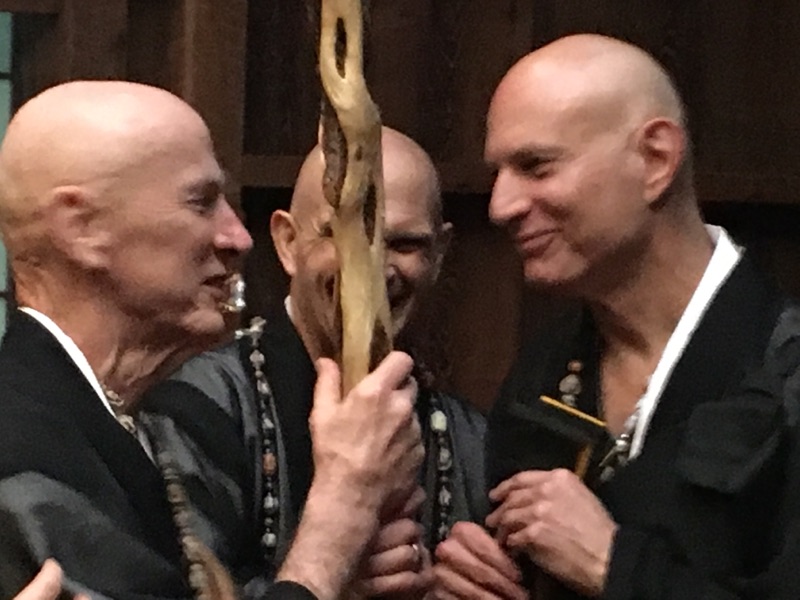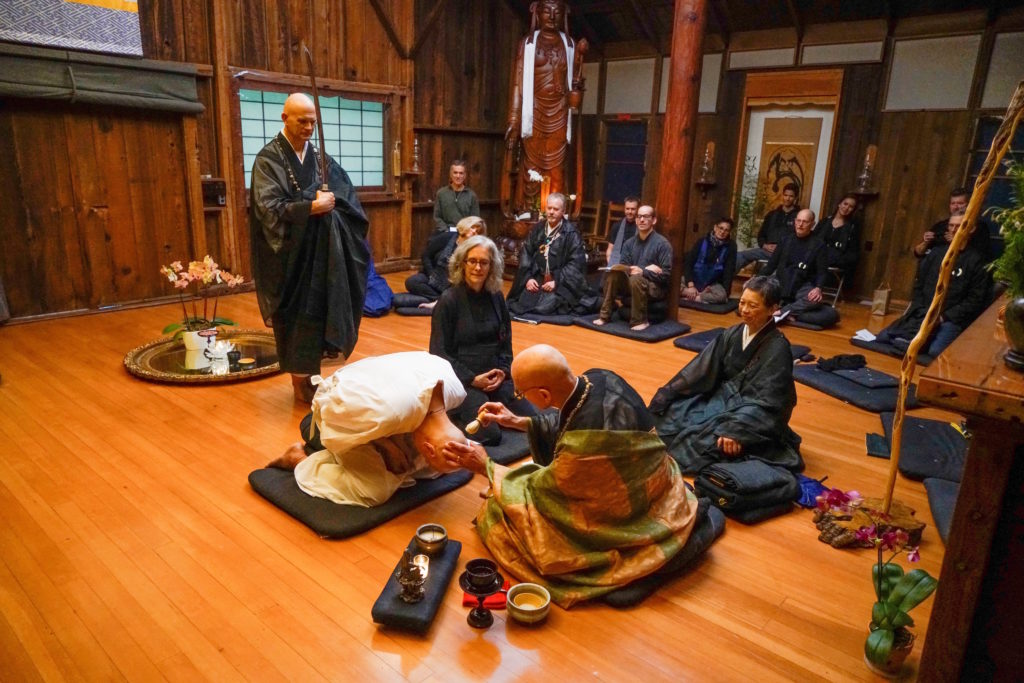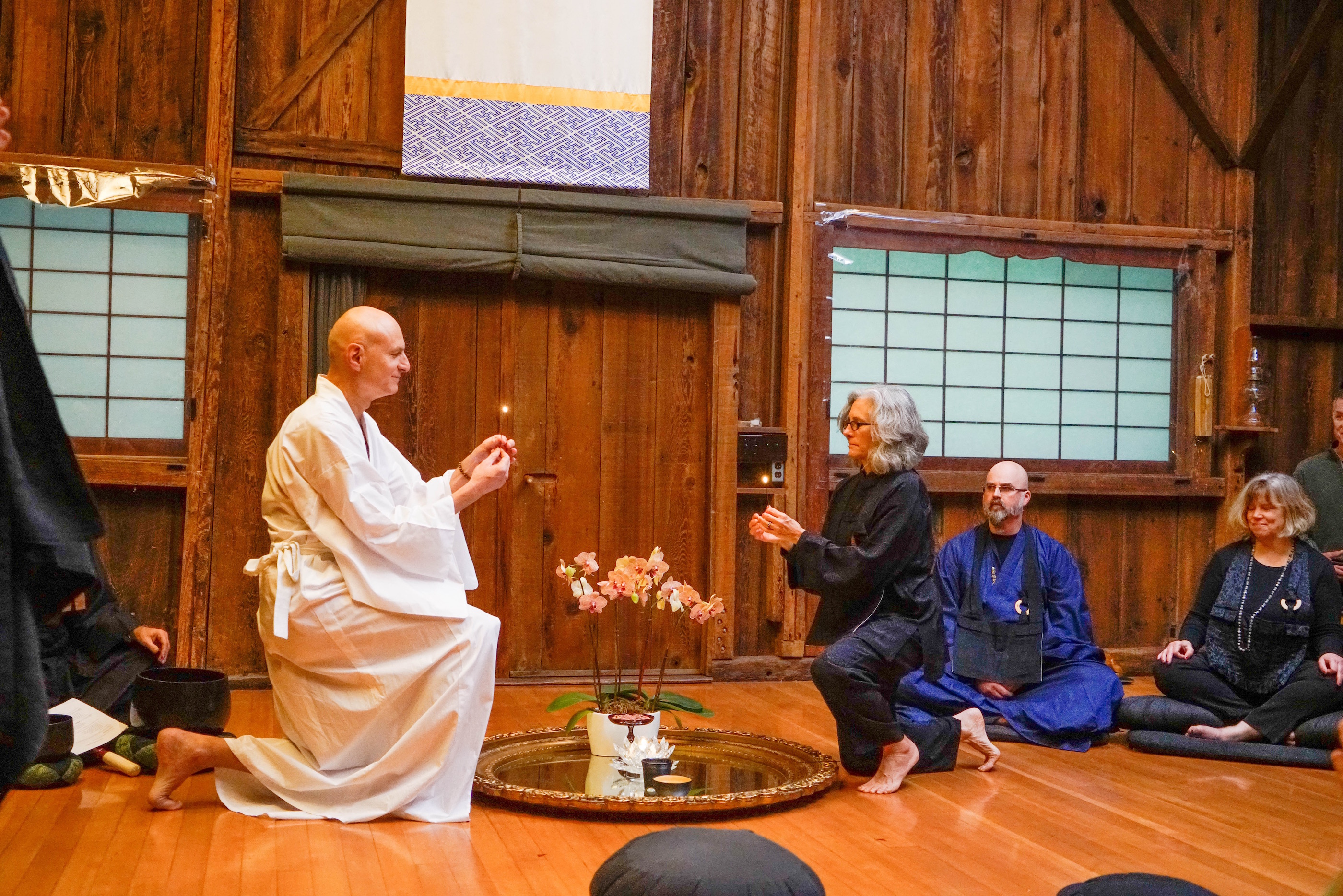
Convention of the Hairless (from L to R): Junpo Denis Kelly, Fugen Tom Pitner, and yours truly. (Photo: Holly Million)
(* A rakasu is a traditional Japanese garment, like a bib, worn around the neck of Zen Buddhists who have taken the precepts. It can also signify Lay Ordination.)
Look out world. I’ve just been ordained as a Zen Priest! Jan. 12, 2017 – a day that will live in infamy!
Jokes aside, I’m not entirely comfortable with the term “priest.” I prefer “Zen Dude.” My motto: “The Priest Abides.” The mission statement of our Hollow Bones Order? We are a sacred order, bringing into being a harmonious and loving world, through the practice of meditative, compassionate awareness and mindful stewardship.
What happens during a Zen ordination ceremony? Much finery and protocol, a lot of bowing, chanting, and taking of vows, and Zen being Zen, lots of room for spontaneity and ribald humor.

Photo by Bodhi William Prince
The photo above shows Junpo, my teacher, applying soap before shaving the last little tuft of hair off the back of my head. The baldness, symbolic of our rebirth into a new awakened life, is designed to remind us of our vows and keep us humble. Since I’m shocked every time I look in the mirror I’d say it’s working. Needing now to always wear a cap to counter the freezing cold also helps.
The first part of the ceremony I enter wearing only a white robe, signifying the seeker’s purity of purpose. Underneath that I had on only underpants. Not being naturally adept at elaborate body movements, much less at wearing finery, I kept wondering how Junpo was dealing with my unintentionally flashing him. He did mention that my shaved face and pate would soon be a female magnet once I added the de rigueur earring. I confessed that my first thought on making the commitment to one year of hairlessness was how it would affect my dating life.
Next to me is Kisen Lynn Bosche who chose to do the ceremony without all the finery. I respect that choice since I myself thought at one time that I might replicate what the Buddha himself did, compositing his robe out of discarded rags. But I knew the greater challenge for me was, and always will be, to care for and wear the highly elaborate traditional regalia.
You might note my friend and mentor Fugen Tom Pitner standing behind me with a huge razor sharp sword. This being Rinzai Zen, the chosen practice of Japanese samurai, Fugen is obliged to cut off my head if he senses any hint of wavering in my commitment. So he didn’t have to wrestle with any drastic decisions, let’s just say that I responded very enthusiastically to every question.
Arriving at this moment has been my clear intention since I finished my previous Hollow Bones retreat a year ago. I realized then that if I truly wanted to move past a life of neurosis I had to dedicate myself to living in Zen Mind. Though I certainly couldn’t have known it then, my stepped up practice over this last year has been huge in supporting me through the dying of my beloved wife and the tremendous grief that followed.
But I saw myself functioning like a Minister in the world long before I officially attained the moniker. For the last 3-4 years I’ve had a post-it note over my desk that reads: “It’s about your Ministry, not your Career!” So I’ve been evolving into some kind of “spiritual or thought leader” long before I knew of exactly what kind.
Ever since I was a teen I was drawn to the dharma. At 15 I found THE BOOK by Alan Watts in our house and devoured it. I read BE HERE NOW by Ram Dass a few years later. I wanted to study and practice Buddhism from those early beginnings but had nowhere to turn in my little East Central Illinois prairie town. I didn’t know it at the time but I wanted to take refuge. That’s the term we use for committing to the Buddhist path: “taking refuge.” Specifically, we take refuge in the “Three Jewels.”
- The Buddha: the model that Siddhartha Gautama provided with his life, waking us to life’s hard realities and pointing the way to enlightenment;
- The Dharma: the teachings themselves, the truth about how life is lived to best minimize suffering and maximize peace and fulfillment;
- The Sangha: the community of fellow practitioners who support each other through the trials of learning and growth.
All three elements are essential to support the path of awakening. Life is hard, full of pain and loss. So taking refuge is both figurative and real. These are the “Three Refuge” vows we take in Hollow Bones:
- I take refuge in the absolute purity of this awakened mind. (Buddha)
- I take refuge in this practice of pure awareness, wisdom, compassion and skillful means. (Dharma)
- I take refuge in this awakening community, and our realization in the truth of the interconnection, interpenetration, and interdependency of all sentient and insentient beings. (Sangha)
Perhaps better known than the Three Refuges is the Bodhisattva Vow, which takes different forms in different Buddhist traditions. I used a version of the Bodhisattva Vow to open my film JOURNEY FROM ZANSKAR, adapting the text from more traditional phrasings to best fit my film’s narrative: Though beings are innumerable, I vow to free them from all suffering. All the different versions of Bodhisattva vows express fundamental paradoxes. The four “Awakened One’s” vows I took for my Hollow Bones ordination no less so:
- However innumerable all beings are, I vow to serve and liberate them all.
- However deep and elusive my shadow states are, I vow to experience and enlighten them all.
- However vast and difficult true teachings are, I vow to embody and master them all.
- However endless my true path may be, I vow to awaken and follow forever.
There are some unique features in these vows of our lay order. Certainly the emphasis on “shadow” is wholly uncharacteristic for most Buddhist traditions. In Hollow Bones we implicitly acknowledge that every human being carries “shadow.” We must root out all unconscious expressions of shadow before we can truly mature as human beings, much less reach the non-dual state of enlightenment. That means we must turn and face all that we typically hide, repress, and deny about ourselves.
We also emphasize embodiment. This human body is our only vehicle of awakening. It cannot be discounted or bypassed on the path to realization. It must be cared for, exercised, well maintained, and properly nourished.
So what does one actually do when one becomes a Zen Dude? For me that question did not become real until late last Fall. Prior to that I was only clear that I needed to pursue the path for selfish reasons. I simply wanted once and for all stop to identifying with my own neuroses. I’d had it. I was tired of my self-created suffering.
“What does being ordained signify?” people started to ask me. Certainly once ordained some people become monks and continue to deepen their study and practice in monasteries. Not for me, thank you. Others found Buddhist churches, building flocks and becoming local institutions. This also doesn’t speak to me. I don’t want to build an institution. So what options does this leave? One thing I know is I want to dedicate the good works of the remainder of my life to the memory of my beloved wife. The rest I’m still sorting out, but here’s some of what I know…
I want to give public dharma talks in Oakland. There is so much suffering in this town. No more or less than anywhere else perhaps, but still. (Does this mean building a flock? I don’t think so but we’ll see.) I want to hang out the proverbial shingle and see if anyone shows up. “Suffering? Here’s a free talk that might help…”
I also want to publish a book about my wife, our relationship, her passing, and how I’ve coped with the grief. Ever since she died, I’ve kept right on writing. A lot of lessons learned from dharma are in there, along with what I think it takes to sustain a good relationship like the one we had, what gifts lie in supporting someone in dying, and how it’s possible to meaningfully and quickly navigate out of the grief.
I also had a surprising, largely inexplicable vision during the HIVE workshop I took in Dec. I’d like to host a TV talk show called LIFE WITH ZEN DUDE – a cross between Dr. Phil and Colbert, with a focus on dharma. We’ll no doubt start on the web and likely never appear on cable or broadcast TV. I want to have everyday people (perhaps with occasional experts or celebrities) talk about their life challenges in ways that are emotional and authentic. I’ll offer them all the support I can from 22 years of men’s work, 30 years of dharma study and practice, and a lifetime of experience. We’ll aim to make it by turns playful and fun, as well as helpful and practical for all those watching.
Meanwhile, you’ll see me hanging out in Beginner’s Mind. Getting nowhere…

Kisen and I lighting incense (photo by Bodhi William Prince)
